As long as there are adventurous spirits, hang gliding will remain a popular sport. While you love getting a bird’s eye view while soaring in the sky, you may also get curious to see things far away clearly as the ground spectators do. In that case, you will need a pair of binoculars.
But they’re not just binoculars. You’ll need powerful ones. Fortunately, there are many powerful binoculars that can deliver and, at the same time, will give you a bang for your buck. But here are some important factors you should consider when buying your first pair of binoculars.
Binoculars come with an “x.” So when the binoculars say “10x,” it means it magnifies the subject ten times. For example, a bird stands 1,000 meters away from you. With the binoculars, the bird will appear as if it’s only 100 meters away as seen with the naked eye.
Of course, your subjects will appear more distant as you’re flying higher up from the ground. Thus, you’ll need binoculars with a decent magnification. However, you should be aware that the higher the magnification, the harder it’s going to keep the image steady since you’re in flight. At most, a 16x magnification is typically the limit that most people can use without the help of a monopod, bipod, tripod, or anything that supports the binoculars. But then, using such a support is nearly impossible while you’re in flight, so the alternative is to try to keep a steady view of what’s down there.
Beyond leisure purposes, much can be said also about the survival uses for binoculars. They provide you to ability to see clearly at distance – to look for shelter, to find help and rescue, or to spot potential threats.
If you’re using binoculars in a dim or low light, you’ll require light-gathering power. The bigger the lens, the easier you will make out dim or faint objects. Thus, a good pair of binoculars can reveal detail in the dark sky better than you could ever think.
However, weight is also an issue – the bigger the lenses, the heavier the binoculars, thus causing hand fatigue. This is why a tripod is needed to enable spectators a hands-free viewing. But then again, using a support is out of the question when you’re hang gliding.
So overall, you may want to pick a compromise between magnification, light-gathering power, and weight. Regular spectators will often choose binoculars with modest specs in all regards. You will want a pair of binoculars with a decent magnification and that’s also powerful, small and light enough to fit your pocket.
Here are some excellent binoculars suggestions that will cater to every hang glider (and outdoorsy folk) of various needs and budget.
Bushnell Powerview 2 10×42
The cheapest on this list of recommended binoculars, the Bushnell Powerview 2 10×42 provides some solid features for its price. While it’s a basic pair of binoculars in terms of features, its aluminum-alloy chassis gives them a premium feel. These binoculars are really made for the outdoors as they can withstand accidental knocks or bumps.
The binoculars feature a reasonably large lens for a decent light transmission, while the ridged focus control wheel is intuitive to use (and quite satisfying, too). They also have rubber grips for a secure hold. Overall, the Bushnell Powerview 2 is a well-designed pair of binoculars at a pretty reasonable price.
Nikon Aculon 16×50 Binoculars
If you’re looking for the best binoculars that won’t dent your budget, the Nikon Aculon 16×50 binoculars should be right up your alley. These binoculars are going to be a solid purchase. Their “A” spherical Multicoated Eco-Glass lenses provide enhanced brightness and clarity with some edge blur. The field of view is 220 feet at 914 meters (1000 yards), which is quite decent. While it is possible to use Aculons without support, some still prefer a tripod, monopod, or bipod, which is excellent as the Aculon has a solid metal (not the flimsy plastic) tripod adapter.
In terms of its night-viewing capabilities, the Nikon Aculon does pretty well. It can also be used for stargazing, although binoculars with at least 20x magnification would be better if you’re looking for a high-powered pair of binoculars for astronomy.
Celestron Skymaster Pro 20×80
The Celestron Skymaster Pro 20×80 binoculars have excellent magnification, paired with large lenses (20×80). They have a wide exit pupil (4 mm) that makes these binoculars ideal for any viewing conditions, especially in dim conditions or at night for stargazing.
These binoculars also feature multi-coated lenses and Bak-4 prisms that deliver a crisp and clear image. They are also equipped with an integrated adapter rod for support (tripod, etc.).
And the best of all, the Celestron Skymaster Pro 20×80 has a pretty reasonable price tag for such an impressive host of features.
Celestron Skymaster Pro 20×100
Both the Celestron Skymaster Pro 20×100 and the 20×800 have the same magnification and the 4-mm wide exit pupil for excellent light-gathering capacity. However, the former obviously has a bigger lens compared to the latter: 20×100 versus 20×80.
Both Celestrons in the 20x or 25x power could be ideal in any viewing conditions, especially during in low light or for stargazing.
As for the price, the Celestron Skymaster Pro 20×100 sits in the mid-range category. If you want a better-performing pair of binoculars for a reasonable price – whether you’re hang gliding, birdwatching, or stargazing – the 20×100’s features easily justify the cost.
Nikon Monarch HG 10×30
When it comes to buying binoculars for hang gliding, naturally you’d want them to be powerful but also compact at the same time. The Nikon Monarch HG 10×30 binoculars may be the one to end your search! Compared to the other binoculars on the list, the Nikon Monarch 10×30 binoculars are relatively portable at only 450 grams. The magnesium alloy body is what makes these binoculars lightweight but durable.
For a compact pair of binoculars, the Nikon Monarch HG 10×30 binoculars have a pretty impressive 10×30 magnification and objection lens size. Their use of ED (extra-dispersion) glass reduces chromatic aberration that can lead to color fringing, while the soft-to-the-touch neck strap provides comfort. They are also equipped with a tripod adaptor, like many other binoculars.
The only drawback is the price, which is at the premium level considering the binocuars’ compact size.



